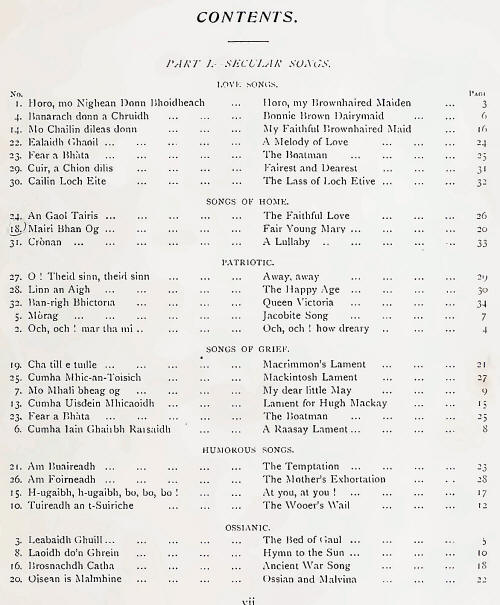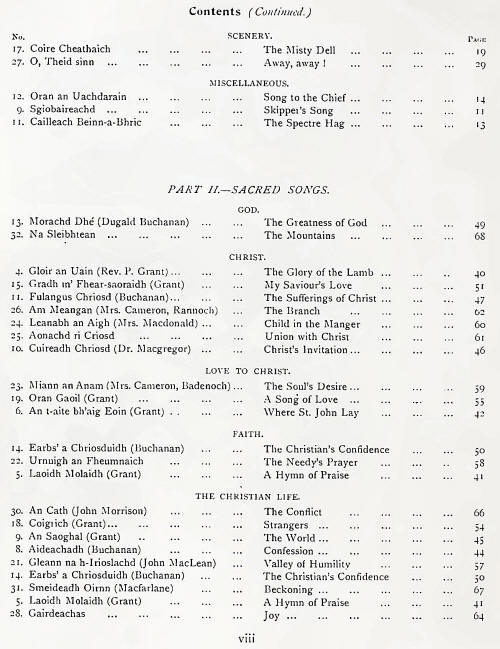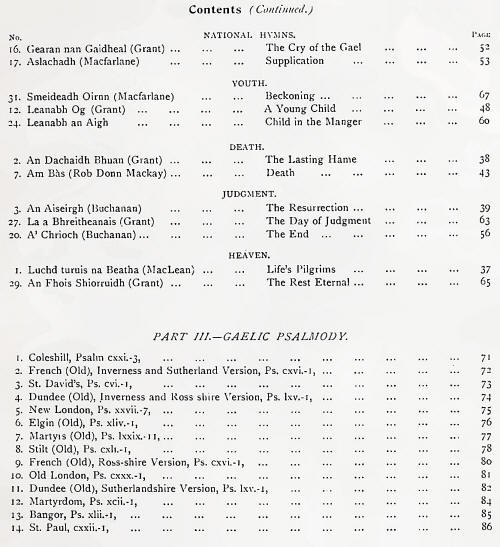|
PREFACE
THE very kind reception
given to this collection by the Press has emboldened the Editor to allow
it to be republished. There are other very excellent collections of
Highland Music and Songs, but as this book contains several melodies not
printed elsewhere (for example, Nos. 3, 8, 16, and 31 of Part I., and
Nos. 2, 4, 5, 6, 8, 9, 11, 12, 15, 16, 18, 19, 22, 23, 24, 25, 26, 27,
28, 29, and 32 of Part 11. and as there is as yet no other collection of
Highland Sacred Music, it is perhaps not desirable that the book should
remain out of print. Cordial thanks are here tendered to the many
friends who have kindly assisted in collecting or revising either tunes
or chords.



HIGHLAND SONGS, HYMNS, AND MUSIC
THE Songs of the Scottish Highlands form a literary
heritage that will well repay study. They are remarkably rich in the
lighter graces of poetry—endless variety of metrical form, and opulence
of rhyme, and melodies that are both striking and sweet. Their
characteristic beauties and their limitations are perhaps both alike due
to their being so intensely native. The feelings expressed are simple,
and scenery and incidents are redolent of the Highlands. At a period
when the popular songs of other countries were stilted and artificial,
the songs of the North were natural and true. English versifiers might
affect longings after the myrtle groves and artificial poses of classic
times, but the Gaelic bards delineated with loving art the beauties of
the mountain landscapes, and the deep, simple emotions of Highland
hearts.
The Love of Nature in all her moods is indeed the deepest
characteristic of Highland song, which in this anticipated the loftier
flights of Burns and Wordsworth. A good example of Duncan Ban
Macintyre’s appreciation of Nature will be found in No. 17 of this
collection, “Coire Cheathaich,” and it pervades the muse of his
contemporary, Alexander Macdonald, whose praise of the moorland heather
is worth translating—
The bonny, clinging, clustering
Dear heather growing slenderly,
With snowy honey lustering
And tassels hanging tenderly;
In pink and brownish proud array,
With springy flexibility,
With scented wig all powdery,
To keep up its gentility.
In more dignified strain we have the ode to the sun by
Ossian, or some unknown bard—
Thou movest in thy might alone,
For who hath power to travel near?
The ageless oak shall yet fall prone,
The hoary hills shall disappear.
The changing main shall ebb and flow,
The waning moon be lost in night,
Thou only shalt victorious go,
Forever joying in thy light.
The Love Songs, numerous, full of headlong passion, and
set to very attractive melodies, form the largest class, and their
fervour and naivete give them a certain piquancy which is not
unpleasing. But the graces and felicities of the Home are not forgotten;
there are many poetic addresses to newly-made brides and frolicking boys
and girls, and lullabies to the babies. One of the most popular songs in
the Highlands is a lilt to a little Highland lassie—
O, my darling Alary, O, my dainty pearl!
O, my rarest Mary, O, my fairest girl!
Lovely little Mary, treasure of my soul,
Sweetest, neatest Mary, born in far Glen Smole.
The Patriotic Songs are a large class, for the
Highlanders love their barren land- — her very dust to them is dear.”
Her historic scenes and the Highland dress, language, and music are
never-failing themes, in discoursing on which the bards occasionally
added such half-serious and wholly forgiveable touches of exaggeration
as the following—
Now, let me tell you of the speech and music of the Gael,
For Gaelic is a charming tongue to tell a bardic tale,
Fain would I sing its praises—pure and rushing, ready, ripe,
For Gaelic’s the best language, the best music is the pipe!
But of all the Northern songs the elegies and other Lavs
of Sorrow are the most striking and characteristic. The Highland Lament
is a thing by itself, having no exact counterpart in any other language,
its wild, rich music presenting a perfect picture of the weird and grand
scenery in which it had its origin. The Gaelic race has been cradled
into poetry by suffering, and its spirit has been bathed in the gloom of
lonely glens and northern skies. Hence its songs have always given
superb expression to what Ossian calls “the joy of grief.” There is,
however, this difference, that while in the older songs the sadness is
unrelieved and oppressive, the more modern introduce a chord of
sweetness to form a very luxury of sorrow. Thus a bard laments the death
of a child—
She died—as dies in eastern skies
The rosy clouds the dawn adorning;
The envious sun makes haste to rise
And drown them in the blaze of morning.
She died—as dies upon the gale
A harp’s pure tones in sweetness blending.
She died—as dies a lovely tale
But new begun, yet sudden ending.
In bright contrast to these lays of grief are
the Humorous Songs—serio-comic ballads, parodies, and biting satires,
the latter being far too numerous.
With the exception of the wickedness in these satiric
outbursts and a passing wave of depravity that swept over Highland poesy
in the end of last century, the songs are pure and noble.
Their Ethics are remarkably high, and their continued popularity and
influence among the Gaelic population must be regarded with
satisfaction.
The Language in which these lyrics have been composed is
one that is unusually well fitted to be the vehicle of sentiment,
readily lending itself to those little garnishments in which Celtic
poets delight. It is rich, mellifluous, and copious in poetic terms,
especially adjectives, which the bards used with lavish but discriminate
profusion. Of its expressiveness and natural poetry, these bards had the
highest opinion—
This is the language Nature nursed
And reared her as a daughter;
The language spoken at the first
By air and earth and water,
In which we hear the roaring sea,
The wind, when it rejoices,
The rushes’ chant, the river’s glee,
The valley’s evening voices.
From a literary point of view one great charm of Gaelic
verse lies in the extraordinary diversity and complexity of
its Metres. Abundant use is made of the ordinary measures familiar in
English poetry —the iambus and the trochee—but recourse is also had to
the difficult anapaest and the high-strung dactyl, and all four are
woven into numberless combinations, such as would delight the soul of an
English poet, but of which English itself is unfortunately incapable on
account of its limited selection of dissyllabic and trisyllabic rhymes.
A common device of the Gaelic bards was to make the latter half of each
stanza the first of the next stanza, as in No. 12, Part I., of this
collection. Gf course, that arrangement required the same rhyme to be
maintained throughout the whole song, but such is the wealth of Gaelic
assonance that this was accomplished with ease. Indeed, it is no unusual
thing for eleven out of twelve lines to rhyme, and sometimes one rhyme
is carried through twenty verses. The most common form of verse in all
Gaelic poetry—Scottish and Irish, ancient and modern—is one in which the
close of one line rhymes with an accented syllable in the middle of the
following line. This leonine rhyme may be exemplified by the opening
verse of the ancient poem known as “The Aged Bard’s Wish ”—
Oh, lay me by the burnie’s side,
Where gently the limpid streams,
Let branches bend above my head,
And round me shed, O Sun! thy beams.
But in many songs every line bristles with rhymed words,
often words of more than one syllable, as in the song No. 16 or hymn No.
4. This free use of intricate rhymes, combined with the headlong sweep
of rhythm found in the best songs, can only be imperfectly reproduced in
English, but an imitation of one of Macdonald’s stanzas may illustrate
some points of the literary structure of Gaelic verse—
Clan Ranald, ever glorious, victorious nobility,
A people proud and fearless, of peerless ability,
Fresh honours ever gaining, disdaining servility,
Attacks can never move them but prove their stability.
High of spirit, they inherit merit, capability,
Skill, discreetness, strength and featness, fleetness and agility ;
Shields to batter, swords to shatter, scatter with facility
Whoever braves their ire and their fiery hostility.
Neither is the aid of apt alliteration neglected in the
adornment of these songs, which indeed possess, in an unusual degree,
all the attractions of form and colour found in the best lyrical poetry.
The Music of Gaelic Songs bears a family resemblance to
that of the Scottish Lowlands, but with all its peculiarities
accentuated. In point of fact, the music of South and North was
originally the same, for the Scottish Lowlanders in discarding the
ancient language of the Scots had the good sense to retain their
melodies. Further, it is well known that from the days of Burns, and
probably from a much earlier date, the national music of Scotland has
been increasingly enriched by the adaptation of Gaelic tunes to Scotch
or English words. These tunes follow closely the rhythm of the Gaelic
words, and therein lie much of their undoubted power and originality.
But this very connection has a peculiar effect on the English songs, to
which many of the airs are wedded. All Gaelic words are accented on the
first syllable, and in consequence lines end with an unaccented, or
sometimes two unaccented syllables. Of course, the melodies follow this
pecularity—the tunes, or parts of a tune, seldom ending on the note
after the bar. In the English and Scotch dialects, however, the range of
dissyllabic and trisyllabic rhymes is extremely narrow, and Scottish
poets have been compelled to eke it out by using diminutives and
plurals, and adding numerous “O's” at the ends of lines, in their
efforts to bend the intractable Saxon tongue to the cadences of Gaelic
music. Similarly the characteristic of Scottish airs, known as “the
Scotch snap,” is to be attributed to the greater difference made in
Gaelic between vowels that are long and accented and those that are
short and unaccented. The absence of the seventh note, B (te), in the
ancient Scottish scale no doubt added to the quaintness of the national
airs, but a much more striking feature was, and is, its modal character.
The old harpers are said to have been extremely fond of the major
mode, an lit, but that mode does not obtain in Gaelic tunes, as now
sung, the predominance which it has in other modern music. One of the
stumbling-blocks which the ordinary musician finds in Scottish music is
that, not content with the ordinary major or even the more uncommon
minor, it must wander away into the rough and unfamiliar Dorian mode.
But in Gaelic music this peculiarity is emphasised, the tunes in the
mode of the second (ray) being, if anything, more numerous than those in
any other mode, while it is not unusual to meet with melodies in the
modes of the third, fourth, and fifth notes of the scale. Probably,
however, the intrinsic beauties of Gaelic airs will be found sufficient
recompense for these and other singularities which, in the eyes of many
admirers, are but additional beauties.
The Hymns of the Scottish Highlands have hitherto
attracted little notice; nevertheless they are fairly numerous and many
of them possess great merit. They are never used in public worship now,
but they were certainly used in early times, and a few hymns o! the
ancient Columban Church have been preserved in monastic
libraries—antique compositions in Latin or Gaelic, or both. In the
middle ages the sacred poetry would seem to have been of a lower lype—imaginary
conversations like the so-called “Prayer of Ossian," preserved in the
Dean of Lismore’s Book (1512), and verses to he used as charms. The
modern sacred poetry of the North began with Dugald Buchanan by the
shores of Loch Kannoch about the middle of last century, but the most
voluminous and popular writer of Gaelic hymns has been the Rev. Peter
Grant of Strathspey, whose collection, first issued in 1809, is highly
esteemed throughout the Highlands and the Gaelic districts of Canada,
under the name of the lays of l'adruig Grannd. Besides these poets there
have been many hymn-writers in the North. MacGregor, MacLean, Morrison,
and others, some of whom have contributed but one successful hymn to the
sacred anthology of their country. In that anthology it will be found
that, along with undoubted orthodoxy, there is a certain echo of the
secular songs, which is particularly noticeable in the use of poetic
phrases such as Din nan tin “God of the elements,” Dia nam feart, “God
of (many) attributes,” Slanuigkear nam bitadh, “Saviour of (many)
victories.” The hymnology of the Highlands shows little trace of the
religious currents of the present century, and its chief characteristic
is a sad earnestness, rising at times into a passionate pessimism. A
stern theology harmonises well with the environment and history of the
Highlander, and whether as Pagan or as Calvinist he is most like himself
when chanting eternal “Misereres” of unutterable pathos. The three great
themes of Highland hymns are Sin, Death, and Judgment a trinity which is
very real to the sacred bard, and whose shadow lies across all his
thoughts. Hence the solemnity and awe of many of the hymns. What English
poet would think of presenting for our meditation a picture such as
this—
For mortal man life is quickly past,
The King of Terrors shall hold him fast,
When sick and dying, behold him crying—
“Ah! tell me, friends, is this death at last?”
“What throes of anguish are these,” he saith,
“That rend my bosom and stop my breath?
New terror thrills me, strange horror chills me —
Oh, tell me truly, can this be death?”
Yet the pages of Buchanan and Grant contain verses even
more terrible than these. At the same time it would be a grave
misrepresentation to say that all Highland hymns are of this gloomy
cast; even in the present collection will be found many Christian songs
of the brightest and happiest description, though, happily, the language
contains no hymns that show the levity frequently found in popular
English hymn-books.
The Sacred Music of the Highlands has a close affinity to
the secular melodies, and in some cases Gaelic and other suitable tunes
seem to have been adapted to sacred words. But numbers of the hymns have
their own proper tunes, many of them sweet, expressive, and in every way
worthy to be the exponents of religious feeling.
Besides the hymn tunes, there is another class of sacred
melodies in the Highlands which is very interesting—the Psalm tunes,
which differ widely from those familiar to the English-speaking world.
This is specially true of the small number of very long and elaborate
tunes that have been used in the North for many generations, and which
are known as the “old” tunes. Their origin is unknown, for though there
is a tradition that they were brought into Scotland by devout Highland
soldiers returning from the Protestant wars of Gustavus Adolphus, they
bear little resemblance to the Psalm tunes of Sweden and Germany. If,
indeed, any such imported foreign music formed the basis of Gaelic
psalmody, the superstructure has probably been moulded by the chants
used in Highland worship before the importation took place. In the Psalm
tunes as we now have them, the predominance of local colouring is very
marked, and it may be said that, even more than the unquestionably
native music of the hymns, these Psalm tunes express the deep
seriousness of Highland religion.
The present collection contains the six “old” tunes, as
well as the Highland forms of the modern Psalm tunes, and in preparing
it the editor has had the intelligent and valuable assistance of
Gaelic-speaking ministers and precentors.
You can download
this book here |

